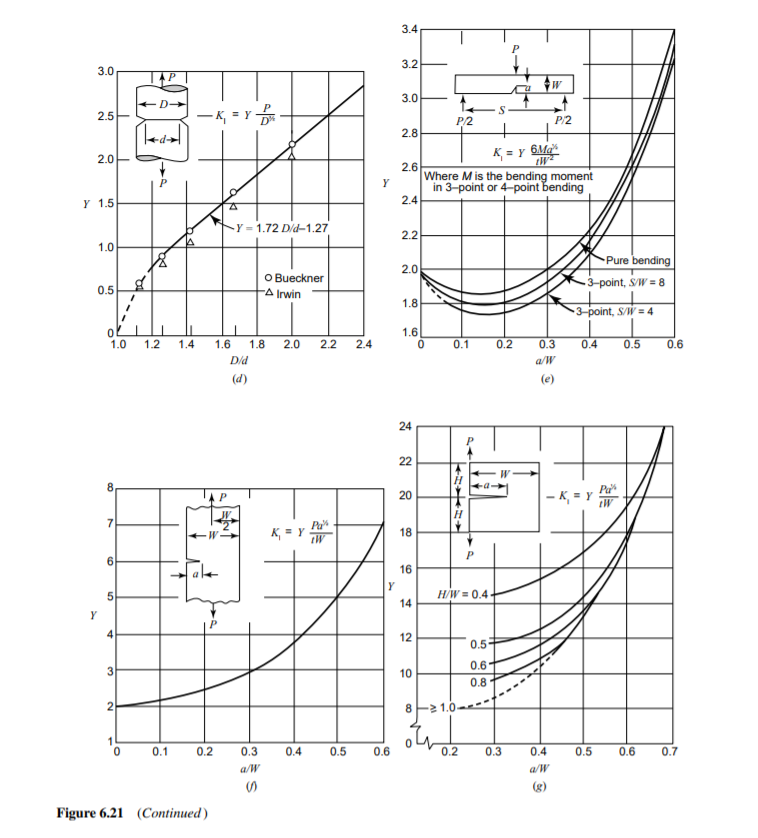3.4 3.2 3.0 3.0 -K, = Y- Tadial 2.5 P/2 P/2 2.8 2.0 K = y 6Ma 2.6 Where M is the bending moment in 3-point or 4-point bending Y 1.5 2.4 Y = 1.72 D/d-1.27 2.2 1.0 Pure bending 2.0 O Bueckner -쇠 Irwin 3-point, S/W = 8 0.5 1.8 3-point, S/W = 4 1.6 1.0 1.2 1.4 1.6 1.8 2.0 2.2 2.4 0.1 0.2 0.3 0.4 0.5 0.6 D/d a/W (d) (e) 24 22 8. Pa - K, = Y 20 Pu K, = Y 18 6. alt 16 H/W = 0.4 14 12 0.5- 0.6 10 0.8 8 1.0 0.1 0.2 0.3 0.4 0.5 0.6 0.2 0.3 0.4 0.5 0.6 0.7 a/W a/W の (g) Figure 6.21 (Continued)
3.4 3.2 3.0 3.0 -K, = Y- Tadial 2.5 P/2 P/2 2.8 2.0 K = y 6Ma 2.6 Where M is the bending moment in 3-point or 4-point bending Y 1.5 2.4 Y = 1.72 D/d-1.27 2.2 1.0 Pure bending 2.0 O Bueckner -쇠 Irwin 3-point, S/W = 8 0.5 1.8 3-point, S/W = 4 1.6 1.0 1.2 1.4 1.6 1.8 2.0 2.2 2.4 0.1 0.2 0.3 0.4 0.5 0.6 D/d a/W (d) (e) 24 22 8. Pa - K, = Y 20 Pu K, = Y 18 6. alt 16 H/W = 0.4 14 12 0.5- 0.6 10 0.8 8 1.0 0.1 0.2 0.3 0.4 0.5 0.6 0.2 0.3 0.4 0.5 0.6 0.7 a/W a/W の (g) Figure 6.21 (Continued)
Elements Of Electromagnetics
7th Edition
ISBN:9780190698614
Author:Sadiku, Matthew N. O.
Publisher:Sadiku, Matthew N. O.
ChapterMA: Math Assessment
Section: Chapter Questions
Problem 1.1MA
Related questions
Question
Consider a steel plate with a through-thickness edge
crack like the one shown in Fig. 6.21f. The plate width (W) is
75 mm, and its thickness (t) is 12.0 mm. Furthermore, the
plane-strain fracture toughness and yield strength values for
this material are 80 MPa m1/2 and 1200 MPa, respectively.
If the application in which the plate is used is expected to
cause a stress of 300 MPa along the axis perpendicular to the
crack, would you expect failure to occur if the crack length a
is 15 mm? Explain.

Transcribed Image Text:3.4
3.2
3.0
3.0
-K, = Y-
Tadial
2.5
P/2
P/2
2.8
2.0
K = y 6Ma
2.6
Where M is the bending moment
in 3-point or 4-point bending
Y 1.5
2.4
Y = 1.72 D/d-1.27
2.2
1.0
Pure bending
2.0
O Bueckner
-쇠 Irwin
3-point, S/W = 8
0.5
1.8
3-point, S/W = 4
1.6
1.0
1.2
1.4
1.6
1.8
2.0
2.2
2.4
0.1
0.2
0.3
0.4
0.5
0.6
D/d
a/W
(d)
(e)
24
22
8.
Pa
- K, = Y
20
Pu
K, = Y
18
6.
alt
16
H/W = 0.4
14
12
0.5-
0.6
10
0.8
8 1.0
0.1
0.2
0.3
0.4
0.5
0.6
0.2
0.3
0.4
0.5
0.6
0.7
a/W
a/W
の
(g)
Figure 6.21
(Continued)
Expert Solution
This question has been solved!
Explore an expertly crafted, step-by-step solution for a thorough understanding of key concepts.
This is a popular solution!
Trending now
This is a popular solution!
Step by step
Solved in 3 steps with 3 images

Knowledge Booster
Learn more about
Need a deep-dive on the concept behind this application? Look no further. Learn more about this topic, mechanical-engineering and related others by exploring similar questions and additional content below.Recommended textbooks for you

Elements Of Electromagnetics
Mechanical Engineering
ISBN:
9780190698614
Author:
Sadiku, Matthew N. O.
Publisher:
Oxford University Press

Mechanics of Materials (10th Edition)
Mechanical Engineering
ISBN:
9780134319650
Author:
Russell C. Hibbeler
Publisher:
PEARSON

Thermodynamics: An Engineering Approach
Mechanical Engineering
ISBN:
9781259822674
Author:
Yunus A. Cengel Dr., Michael A. Boles
Publisher:
McGraw-Hill Education

Elements Of Electromagnetics
Mechanical Engineering
ISBN:
9780190698614
Author:
Sadiku, Matthew N. O.
Publisher:
Oxford University Press

Mechanics of Materials (10th Edition)
Mechanical Engineering
ISBN:
9780134319650
Author:
Russell C. Hibbeler
Publisher:
PEARSON

Thermodynamics: An Engineering Approach
Mechanical Engineering
ISBN:
9781259822674
Author:
Yunus A. Cengel Dr., Michael A. Boles
Publisher:
McGraw-Hill Education

Control Systems Engineering
Mechanical Engineering
ISBN:
9781118170519
Author:
Norman S. Nise
Publisher:
WILEY

Mechanics of Materials (MindTap Course List)
Mechanical Engineering
ISBN:
9781337093347
Author:
Barry J. Goodno, James M. Gere
Publisher:
Cengage Learning

Engineering Mechanics: Statics
Mechanical Engineering
ISBN:
9781118807330
Author:
James L. Meriam, L. G. Kraige, J. N. Bolton
Publisher:
WILEY